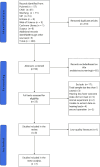Effects of triple semicircular canal plugging on hearing in patients with Meniere's disease: A systematic review and meta-analysis
- PMID: 39637038
- PMCID: PMC11620686
- DOI: 10.1371/journal.pone.0314348
Effects of triple semicircular canal plugging on hearing in patients with Meniere's disease: A systematic review and meta-analysis
Abstract
Introduction: Triple semicircular canal plugging is effective in controlling vertigo in patients with Meniere's disease, however, whether the rate of causing hearing loss during treatment is still not uniform. This study aimed to evaluate the effects of Triple semicircular canal plugging (TSCP) on hearing in Meniere's disease (MD) patients.
Methods: Databases Reviewed were PubMed, EMBASE, Scopus, Clinical Trials, Web of Science, Cochrane Library, CNKI, Wanfang, and VIP. The study reported on the duration, follow-up time, hearing loss, and vertigo control outcomes in MD patients evaluated by TSCP. Stata 17 software was used for data analysis and assessing the risk of bias.
Results: This meta-analysis included 367 MD patients from 7 studies. TSCP efficiently alleviated vertigo with a rate of 99% (95% CI: 0.97, 1.00) and had a hearing loss rate of 22% (95% CI: 0.16, 0.28). Subgroup analysis revealed that for hearing loss, the proportion of patients with disease duration more than or less than 12 months was 14% (95% CI: 0.05, 0.26) and 24% (95% CI: 0.19, 0.29), respectively. For vertigo control, the rates were 100% (95% CI: 0.96, 1.00) and 99% (95% CI: 0.97, 1.00), respectively. For hearing loss, the follow-up time of MD patients more than or less than 24 months was 20% (95% CI: 0.07, 0.38) and 23% (95% CI: 0.18, 0.29), respectively. For vertigo control, the rates were 99% (95% CI: 0.95, 1.00) and 99% (95% CI: 0.97, 1.00), respectively. The duration of the disease and follow-up time had no significant impact on hearing loss and vertigo control rates.
Conclusions: TSCP was efficient for vertigo control but with a risk of hearing loss. It could be used as a surgical method for hearing preservation in advanced MD patients.
Copyright: © 2024 Zhu et al. This is an open access article distributed under the terms of the Creative Commons Attribution License, which permits unrestricted use, distribution, and reproduction in any medium, provided the original author and source are credited.
Conflict of interest statement
The authors have declared that no competing interests exist.
Figures



References
Publication types
MeSH terms
LinkOut - more resources
Full Text Sources
Medical

